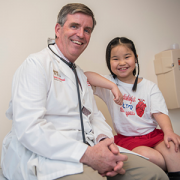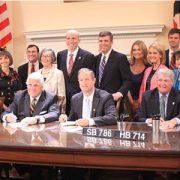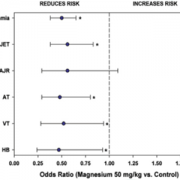Prescription for a healthy heart: pediatric-driven partnerships

Dr. Martin and a patient share a smile after a visit at Children’s National Health System.
For pediatric cardiologists, February, National Heart Month, is a special time. We share health tips in the hospital and talk about heart health with those looking for advice, especially with patients and families impacted by congenital heart disease (CHD). It’s also a time to look back at what’s worked well in the field, while accelerating advancements for CHD treatment.
To start, congenital heart disease, a structural abnormality of the heart or of the blood vessels surrounding it, is the most common birth defect and occurs in about one in every 100 live births, affecting 40,000 babies born in the U.S. each year. One million children and 1.4 million adults in the U.S. have CHD. Over the past 15 years, pediatric cardiologists have cut mortality rates for CHD in half. Gratefully, now instead of saving children’s lives, the emphasis is on improving them. The catalyst for this paradigm shift isn’t simply due to a medical breakthrough, but is also the result of collaboration and advocacy.
Pediatric cardiologists worked together with other stakeholders – nurses, neonatologists, parents, state and federal agencies – to implement newborn screening methods in hospitals, with the introduction pulse oximetry screenings for critical congenital heart defects (CCHD). The screening, which measures blood oxygen levels in newborns, focuses on screening babies for CCHD before they leave the hospital. The concept and a national protocol for screening began with a small project in 2002, was endorsed by medical associations by 2012 and required by all states in 2018. The impact of CCHD screening of newborns is remarkable. Data published in JAMA showed a 33 percent reduction in CCHD infant deaths associated with states that required CCHD screening.
The pulse oximetry screening’s impact on the number of lives saved goes beyond identifying newborns with CCHD. Worldwide, though the detection of secondary conditions, such as hypothermia, pneumonia, and sepsis, the pulse oximetry screening is estimated to save roughly 772,000 lives by 2030.
In addition to newborn screening recommendations for CCHD, a group of cardiologists, including myself, worked for the Joint Council on Congenital Heart Disease (JCCHD) to form and support the National Pediatric Cardiology Quality Improvement Collaborative (NPC-QIC). We developed measures to see how we could improve survival rates between surgeries for infants born with hypoplastic left heart syndrome (HLHS), one of the most common and severe forms of CCHD.
Babies born with HLHS require two heart surgeries within the baby’s first six months. Babies that survived the first operation had a significant mortality rate (15 percent) and frequent growth failure, while waiting for the second operation. Our focused aims were to both decrease the death rate and improve growth in these children. We analyzed data from medical centers, utilized quality improvement principals from the Institute for Health Care Improvement, talked with doctors and families, and invited teams from across the U.S. to partner with us to put quality and safety measures into place.
We emphasized the following points:
- Clear communication. Parents leaving the hospital received consistent messages about CHD, the type of surgery their baby had, next steps and how to care for their child at home.
- Improved nutrient intake. Parents received clear guidelines about how many calories babies needed to consume, were asked to weigh their baby each day, and taught how to augment feeding.
- Warning signs.Parents received a list of typical infant behaviors and HLHS red flags to watch out for, such as if a baby isn’t gaining a certain amount of weight. They received monitors to measure oxygen saturation levels at home. If oxygen saturation dropped significantly or if parents noticed a problem, they called their doctor immediately.
The implementation of these procedures reduced interstage mortality rates and the number of growth failures for HLHS patients. In 2008, six centers participated in the NPC-QIC pilot. By 2018, 65 medical centers in the U.S. and Canada used these methods. Similar to the pulse oximetry screening guidelines, this new method wasn’t the result of a medical breakthrough, but the result of shared learning and shared infrastructure.
Now, we’re referring more adult congenital heart patients to board-certified adult congenital heart disease (ACHD) specialists, a better fit than internists or pediatric cardiologists. Adults with congenital heart defects should have their heart examined at least once by a specialist and those with complex needs should meet with a specialist at least every two years. More than 300 board-certified ACHD specialists practice in the U.S. and the field is growing. The third ACHD board exam takes place this year.
Over the next few decades, I hope we’ll make even more progress with understanding, diagnosing and treating CHD.
Emerging research examines genetic clues for congenital heart defects, which were once thought to account for 8 percent of cases and may now account for 30 percent of conditions. We’re working with neurologists to examine the timing and pathway of potential oxygen inefficiencies that occur as the brain develops in utero, infancy, and after neonatal surgery. We’ve come a long way, but we continue looking at new frontiers and for innovative solutions.
Fortunately, as cardiologists, we’re good at fixing problems. We work with surgeons and medical teams to repair holes in hearts, or replace them, and reroute blood from an underdeveloped left ventricle to improve circulation. For almost every heart defect, we have evidence-based solutions. However, to continue to help children worldwide, it’s imperative that we don’t forget about what works well: good science, tracking data, sharing best practices, active listening, transparency and constant collaboration.
Gerard Martin, M.D., F.A.A.P., F.A.C.C., F.A.H.A., is a cardiologist and the medical director of global services at Children’s National Health System. Dr. Martin has practiced pediatric cardiology for 34 years and is the Dan G. McNamara keynote speaker at the American College of Cardiology’s 2019 Scientific Sessions. Follow Dr. Martin on Twitter @Gerard_MD.
This article first appeared on KevinMD.com.











